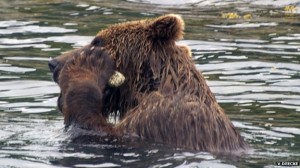It was once thought that only humans used tools, but no longer. More and more examples are being discovered in other species.
Examples include …
- chimpanzees in the Fongoli savanna sharpen sticks to use as spears when hunting (2007) – This is considered to be the first evidence of systematic use of weapons in a species other than humans.
- Orangutans have also been observed using sticks to measure the depth of water.
- Wild capuchin monkeys in many areas use stone hammers and anvils to crack nuts and encased seed (2004. Wild capuchin monkeys (Cebus libidinosus) use anvils and stone pounding tools. American Journal of Primatology 64:359-366.)
- Elephants have also been known to drop large rocks onto an electric fence to either ruin the fence or cut off the electricity (Poole, Joyce (1996). Coming of Age with Elephants. Chicago, Illinois: Trafalgar Square. pp. 131–133, 143–144, 155–157. ISBN034059179X.)
- Sea otters have been observed using stones to hammer abalone shells off rocks.
- the octopus has also been conclusively shown to use tools.
This is not a definitive list, there are many more examples, and more and more are turning up.
 The latest example is the Brown Bear. The BBC reports a few days ago …
The latest example is the Brown Bear. The BBC reports a few days ago …
A wild brown bear has been photographed using a barnacle-covered rock to exfoliate in the first recorded act of tool use by the species.
The observation was made in Glacier Bay National Park, Alaska by the University of Cumbria’s Dr Volker Deecke.
OK, that’s a news report. Dr Deecke’s observations, which were made while he was on holiday in Alaska, have been published in the journal Animal Cognition. The abstract gives more detail, and reads …
This is the first report of tool-using behaviour in a wild brown bear (Ursus arctos). Whereas the use of tools is comparatively common among primates and has also been documented in several species of birds, fishes and invertebrates, tool-using behaviours have so far been observed in only four species of non-primate mammal. The observation was made and photographed while studying the behaviour of a subadult brown bear in south-eastern Alaska.
The animal repeatedly picked up barnacle-encrusted rocks in shallow water, manipulated and re-oriented them in its forepaws, and used them to rub its neck and muzzle. The behaviour probably served to relieve irritated skin or to remove food-remains from the fur. Bears habitually rub against stationary objects and overturn rocks and boulders during foraging and such rubbing behaviour could have been transferred to a freely movable object to classify as tool-use. The bear exhibited considerable motor skills when manipulating the rocks, which clearly shows that these animals possess the advanced motor learning necessary for tool-use. Advanced spatial cognition and motor skills for object manipulation during feeding and tool-use provide a possible explanation for why bears have the largest brains relative to body size of all carnivores. Systematic research into the cognitive abilities of bears, both in captivity and in the wild, is clearly warranted to fully understand their motor-learning skills and physical intelligence related to tool-use and other object manipulation tasks.
No, I’m not highlighting this to be skeptical about it, but rather to simply point it out with a “Hey this is Cool” comment.
Bears are smart … talk to any park ranger who needs to deal with them. Apparently it is very challenging to design a bear-proof bin that most humans can open but at the same time keep the bears out. The problem is that some bears have more mechanical aptitude than some humans, but then I guess the bears are also highly motivated (We see a rubbish bin, then see a food larder)
The best bear story I heard from a ranger involved an elderly couple out for a drive in a park. Apparently, after stopping at a viewpoint, they got to take pictures and did not notice that a bear had been attracted by the aroma of their picnic in the back of their car, until it was too late. The bear had clambered in and was happily enjoying it all. Unsure what to do, then both got back in, and with the bear still in the back, carefully drove to a nearby ranger station. Leaving his terrified wife sitting in the passenger seat, the elderly chap went in and asked the ranger to get the bear out of the car. Unsure what this chap was on about, the ranger wandered out, and was rather astonished at the sight. Having now finished all the food, the bear had clambered into the front and was sat in the driver’s seat with its paws on the steering wheel and as if it had just driven up, and yes the elderly lady was still apparently sitting in the passenger seat too afraid to move.
If you need further proof, well apparently some bears are also rather fond of beer as well, but not just any beer …
When state Fish and Wildlife agents recently found a black bear passed out on the lawn of Baker Lake Resort, there were some clues scattered nearby — dozens of empty cans of Rainier Beer.
The bear apparently got into campers’ coolers and used his claws and teeth to puncture the cans. And not just any cans.
“He drank the Rainier and wouldn’t drink the Busch beer,” said Lisa Broxson, bookkeeper at the campground and cabins resort east of Mount Baker.
Fish and Wildlife enforcement Sgt. Bill Heinck said the bear did try one can of Busch, but ignored the rest. The beast then consumed about 36 cans of Rainier.
BBC story for the above is here.